Domestic anti-tank guns
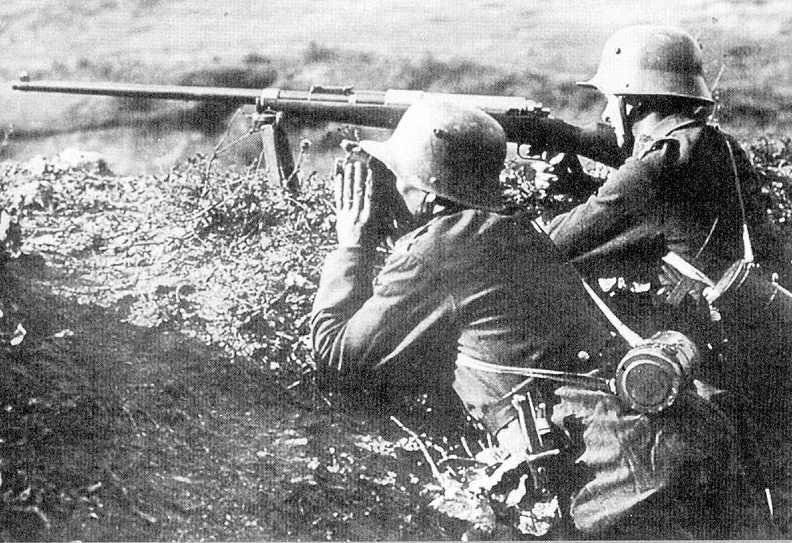
In the 20-30s, a light small-caliber gun or a large-caliber machine gun seemed to the majority of specialists to be the most successful and versatile solution to two tasks — anti-aircraft defense at low altitudes and anti-tank at close and medium ranges. It would seem that this view was confirmed by the Spanish civil war 1936-1939 (although in the course of those battles, both sides except the 20-mm automatic cannon used the remaining 13,37-mm Mauser "MTR. However, by the end of the 30-x it became clear that the "universal" or "anti-tank" machine gun (12,7-mm Browning, DShK, Vikkers, 13-millimeter Hotchkis, 20-millimeter Erlikon, Solothurn, “Madsen”, 25-millimeter “Vickers”) cannot be used at the front edge by small infantry units by combining their weight and size indicators and performance. Large-caliber machine guns during the Second World War, as a rule, were used for the needs of air defense or for firing of fortified firing points (a characteristic example is the use of the Soviet 12,7-millimeter DShK). True, they armed light armored vehicles, along with anti-aircraft guns, were attracted to anti-tank guns, even included in anti-tank reserves. But the heavy machine gun did not become an anti-tank weapon itself. Note that the 14,5-mm machine gun Vladimirov KPV, which appeared in 1944 year, although it was created under the cartridge of an anti-tank gun, by the time of its appearance could not fulfill the role of "anti-tank". After the war, it was used as a means of fighting manpower at considerable distances, air targets and light armored vehicles.
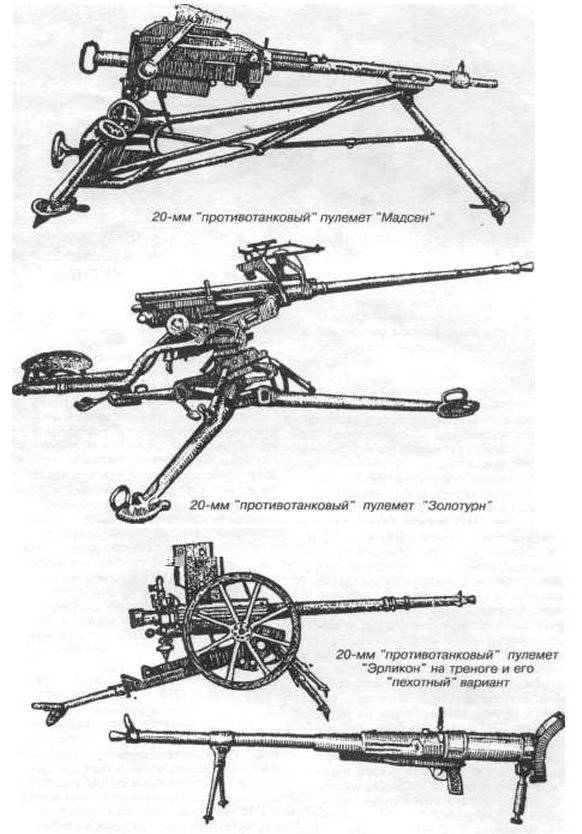
The anti-tank guns used during World War II differed in caliber (from 7,92 to 20 millimeters), type (self-loading, magazine, single-shot), size, weight, layout. However, their design had a number of common features:
- high initial speed of the bullet was achieved through the use of a powerful cartridge and a long barrel (90 - 150 caliber);
- used cartridges with armor-piercing tracer and armor-piercing incendiary bullets that had armor-piercing and sufficient armor-piercing effect. Note that attempts to create anti-tank rifles for the mastered cartridges of large-caliber machine guns did not give satisfactory results, and the cartridges were developed on purpose, and converted cartridges were used in 20-mm anti-tank rifles for aviation guns. 20-mm anti-tank missiles have become a separate branch of "anti-tank machine guns" of the 20-30s of the last century;
- To reduce recoil installed muzzle brakes, spring shock absorbers, soft cushion butts;
- to increase maneuverability, the size of the mass and the PTR was reduced, carrying handles were introduced, and heavy rifles were introduced quickly;
- in order to quickly carry fire, the bipods were fastened closer to the middle; for uniformity of aiming and convenience, many samples were supplied with a “cheek”, butt shoulder, for control in most of the samples a pistol grip served, a special handle or butt was used to hold when firing with the left hand;
- maximum reliability of mechanisms was achieved;
- great importance attached to the ease of development and production.
The problem of rate of fire was resolved in conjunction with the requirement of simplicity of design and maneuverability. Single-shot anti-tank guns had 6-8 rounds of fire per minute, shop-gunners had 10-12, and self-loading guns had 20-30.
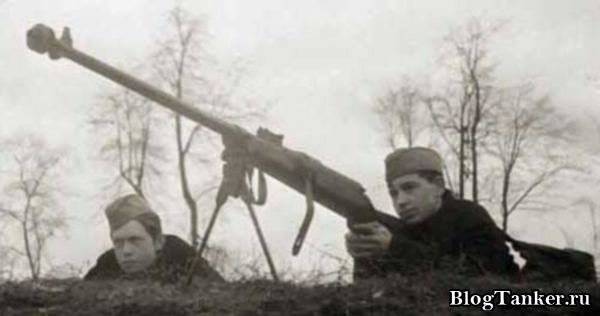
In the USSR, a government decree on the development of anti-tank guns appeared 13 March 1936 of the year. Designing 20-25 rifles with millimeter rifles weighing up to 35 kilograms was entrusted to S.A. Korovina M.N. Blumu and S.V. Vladimirov. Before 1938, 15 samples were tested, but none of them met the requirements. So, in 1936 at the Kovrovsky plant No. XXUMX them. Kirkizh produced two prototypes of the INN-2 M.N. 20-mm "company anti-tank rifle". Blum and S.V. Vladimirova - on the wheeled carriage and bipod. In August, eight anti-tank weapons systems for the company level were tested on 10 in Shchurovo at the Small Arms Research and Development Range:
- 20-millimeter anti-tank gun INZ-10;
- 12,7-millimeter anti-tank rifle, reworked NIPSVO from the German "Mauser";
- Vladimirov 12,7-millimeter anti-tank gun;
- 12,7-millimeter anti-tank gun TsKB-2;
- 14,5-millimeter anti-tank gun systems of Vladimirova and NPSVO (14,5-mm cartridge developed NIPSVO);
- 25-millimeter self-loading gun MTs (43-K system Tsyrulnikova and Mikhno);
- 37-mm recoilless gun DR.
The INZ-10 lightweight self-loading cannon showed poor armor penetration and accuracy. The mass of weapons in the combat position was also large (41,9 - 83,3 kg). The rest of the systems were either found to be unsatisfactory, or they needed serious modifications. At the beginning of the 1937 of the year, the NPSSVO conducted tests of an experienced Tula self-loading 20-mm anti-tank gun (gun) TsKBSV-51 developed by S.А. Korovin. This gun had a tripod and optical sight. However, it was also rejected due to insufficient armor penetration, large mass (47,2 kg) and unsuccessful design of the muzzle brake. In 1938, B.G. proposed his lightweight 37-mm anti-tank gun. Shpitalny, head of OKB-15, however, she was rejected even before the tests began. The attempt to convert the automatic 20-millimeter Shpitalny and Vladimirov (ShVAK) cannon into a “universal” anti-tank anti-tank weapon also failed. In the end, the requirements themselves for anti-guns were considered inappropriate. November 9 The 1938 of the Artillery Directorate formulated new requirements. The powerful 14,5-millimeter cartridge, having a B-32 armor-piercing incendiary bullet with a red-hot steel core and a pyrotechnic incendiary composition (similar to the B-32 rifle bullet), was finalized. Incendiary composition was placed between the shell and the core. Series production of the cartridge began in the year 1940. The weight of the cartridge left 198 grams, bullets - 51 grams, the length of the cartridge was 155,5 millimeters, sleeves - 114,2 millimeters. A bullet at a distance of 0,5 km at a meeting angle of 20 degrees was able to penetrate 20-mm cemented armor.
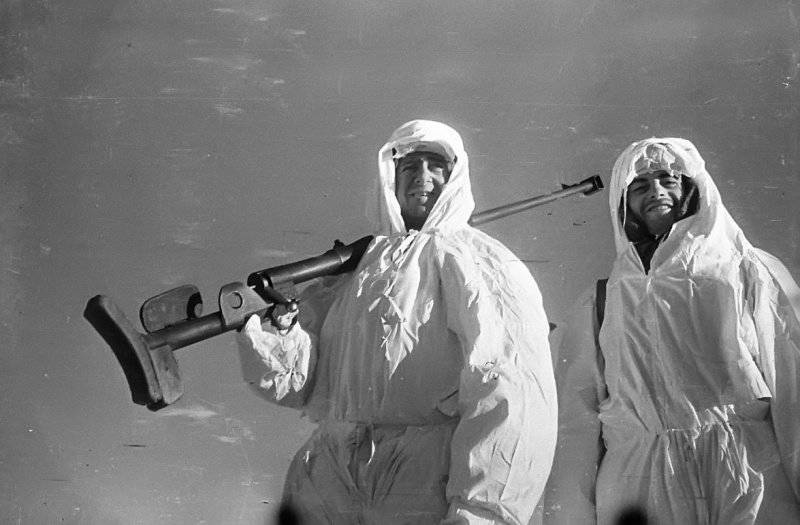
N.V. Rukavishnikov developed a very successful self-loading rifle under this cartridge, the rate of which reached 15 rounds per minute (the self-loading 14,5-mm anti-tank rifle developed by Shpitalny again failed). In August 1939, it successfully passed the test. In October of that year he was adopted by the designation PTR-39. However, in the spring of 1940, Marshal G.I. Kulik, head of the GAU, raised the issue of the inefficiency of existing anti-tank weapons against the “latest tanks Germany ”, about which intelligence appeared. In July 1940, the production of PTR-39 for production by the Kovrov Plant named after Kirkizha was suspended. Erroneous views that the armor protection and firepower of tanks will increase significantly in the near future had a number of consequences: anti-tank rifles were excluded from the weapons system (order of August 26, 1940), they stopped production of 45-mm anti-tank guns, and they issued an urgent design task 107- millimeter tank and anti-tank guns. As a result, the Soviet infantry lost an effective anti-tank melee weapon.
In the first weeks of the war, the tragic consequences of this mistake became visible. However, 23 June tests of Rukavishnikov's anti-tank guns showed a still large percentage of delays. Launching and putting this gun into production would take considerable time. True, some Rukavishnikov anti-tank rifles were used in parts of the Western Front during the defense of Moscow. In July, the 1941 of the year as a temporary measure in the workshops of many Moscow universities launched the assembly of a single-shot anti-tank gun under the 12,7-millimeter DShK cartridge (this gun was proposed by VN Sholokhov, and it was considered as early as the 1938 year). A simple design copied from the old German 13,37-millimeter anti-tank gun "Mauser". However, a muzzle brake, a shock absorber on the back of the butt was added to the design, and light folding bipods were installed. Despite this, the design did not provide the required parameters, especially since the armor penetration of the 12,7-mm cartridge was not sufficient to fight tanks. Especially for these anti-tank guns in small batches produced a cartridge that has an BS-41 armor-piercing bullet.
Finally, in July, an 14,5-mm cartridge, having an armor-piercing incendiary bullet, was officially put into service. To speed up work on a technologically advanced and efficient 14,5-millimeter anti-tank rifle, Stalin at the meeting of the State Defense Committee proposed to entrust the development to "one more, and for reliability - to two designers" (according to DF Ustinov's memoirs). The assignment was issued in July by S.G. Simonov and V.A. Degtyarev. A month later, the constructions were presented, ready for testing - from the moment of receiving the assignment to the test shots, the entire 22 day passed.
V.A. Degtyarev and employees of KB-2 plant them. Kirkizha (INZ-2 or Plant No. 2 of the People's Commissariat of Weapons) 4 July began the development of the 14,5-mm anti-tank gun. At the same time developed two store options. 14 July working drawings were transferred to production. The draft anti-tank gun Degtyarev 28 July reviewed at a meeting in the Office of small arms of the Red Army. Degtyarev 30 July offered to simplify one sample, redoing it into a single-shot. This was necessary to accelerate the organization of mass production of anti-tank guns. A few days later the sample was already submitted.
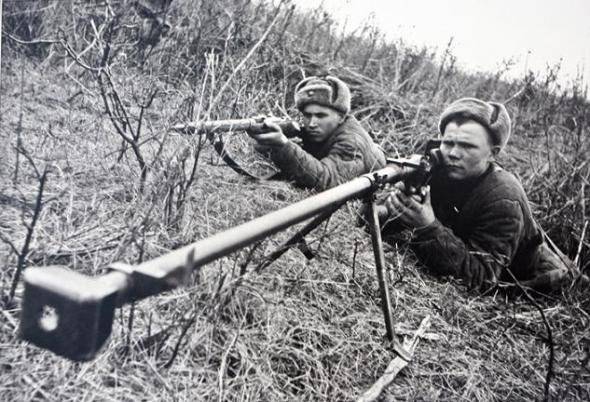
At the same time, work was done on fine-tuning the cartridge. 15 August adopted a version of the 14,5-millimeter cartridge with a BS-41 bullet having a powder-metal-ceramic core (the bullet weight was 63,6 g). Bullet developed the Moscow plant of hard alloys. The 14,5-mm cartridges differed in color: the B-32 bullet nose was painted black, there was a red belt, the BS-41 bullet was painted red and had a black nose. The cartridge primer was covered with black paint. Such coloring allowed the armor rider to quickly distinguish the cartridges. Produced cartridge with bullet BZ-39. Based on BS-41, an “armor-piercing-incendiary-chemical” bullet with a capsule with a HAA gas-forming compound in the rear part was developed (the German “armor-piercing-chemical” cartridge to Pz.B 39 served as a model). However, this cartridge was not accepted. Acceleration of work on anti-tank guns was necessary, as the problems of the rifle units of rifle units exacerbated - in August, because of the lack of anti-tank artillery, 45-mm guns were withdrawn from the divisional and battalion units to form anti-tank artillery brigades and regiments, 57-millimeters, in millimeters, in millimeters, to form anti-tank artillery brigades and regiments, XNUMX-millimeters, in millimeters, are in millimeters, to form anti-tank artillery brigades and regiments. production due to technological problems.
August 29 1941, after the demonstration to the members of the State Defense Committee, the self-loading model Simonov and the single-shot Degtyarev were adopted under the designation PTRS and PTRD. Due to the haste of the issue, the guns were taken before the end of the tests - tests of anti-tank guns for survivability were carried out on September 12-13, final tests of the modified anti-tank guns - September 24. New anti-tank guns were supposed to fight with light and medium tanks, as well as with armored vehicles at a distance of up to 500 meters.
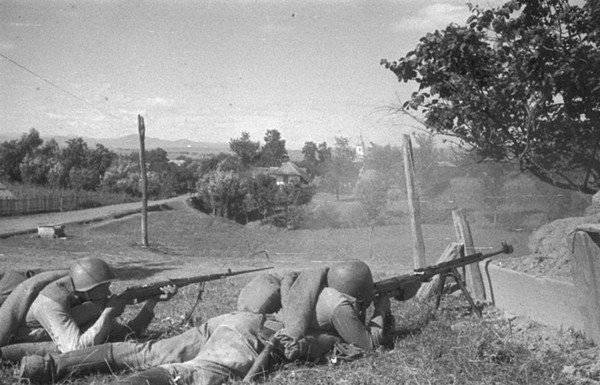
Production of TPRD was started at the plant number 2 them. Kirkizha - in the first days of October, the first batch consisting of 50 rifles was put on the assembly. In the Department of Chief Designer 10 October created specials. documentation team. Urgently the conveyor was organized. Out of turn the equipment and the tool prepared. October 28 was created by the specialized production of anti-tank guns under the guidance of Goryachiy - at that time, the task of anti-tank weapons was a priority. Later, Izhmash, the production of the Tula Arms Plant, which had been evacuated to Saratov and others, joined the production of anti-tank guns.
The single-shot anti-tank gun of Degtyarev consisted of a barrel having a cylindrical receiver box, a longitudinally rotary sliding bolt, butt having a trigger box, trigger and impact mechanisms, a bipod, and sighting devices. There were 8 rifling channels in the bore with a stroke length equal to 420 millimeters. The active box-shaped muzzle brake was able to absorb up to 60% recoil energy. The cylindrical bolt had a straight handle in the back and two lugs in the front, it was installed percussion mechanism, the reflector and the ejector. The percussion mechanism included a mainspring and a hammer with a striker; the tail of the drummer looked like a hook and went outside. The bevel of his skeleton, when unlocking the bolt, took the drummer back.
The barrel and trigger boxes were connected tightly connected to the inner tube of the stock. The inner tube, having a spring damper, was inserted into the stock tube. After the shot, the mobile system (bolt, receiver and barrel) was retracted, the bolt handle “raided” on the copy profile attached to the butt, and when it was turned, it unlocked the bolt. After stopping the barrel, the valve retreated backward by standing on the slide delay (the left side of the receiver), while the sleeve was pushed by the reflector into the lower window in the receiver. The spring of the shock absorber returned the moving system to the forward position. The insertion in the upper window of the receiver of the new cartridge, its dispensing, as well as the locking of the bolt, was done manually. The trigger mechanism included the trigger, the trigger lever and the sear with springs. Sights were carried to the left on the brackets. They included a front sight and reversible rear sight at a distance up to and above 600 meters (in anti-tank rifles of the first releases, the rear pillar moved in a vertical groove).
On the butt there was a soft pillow, a wooden stop designed to hold the gun with his left hand, a wooden pistol grip, a “cheek”. Folding stamped bipods on the trunk were fastened with a yoke with a lamb. The handle was also attached to the barrel with which the weapon was carried. The accessory included a pair of canvas bags each for 20 cartridges. The total weight of the anti-tank gun Degtyarev with ammunition was approximately 26 kilogram. In combat, the gun was transferred by the first or both numbers of the calculation.
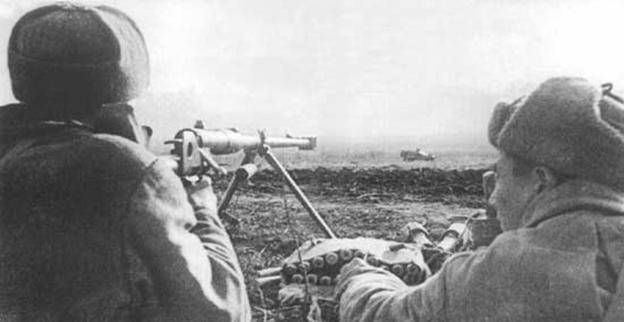
The minimum of parts, the use of the butt tube instead of the frame, greatly simplified the production of anti-tank guns, and the automatic opening of the shutter increased the rate of fire. Degtyarev's anti-tank rifle successfully combined simplicity, efficiency and reliability. The speed of production production was of great importance in those conditions. The first batch in the 300 units of the TPRD units was completed in October and at the beginning of November it was sent to Rokossovsky's 16 army. 16 November they were first used in combat. By December 30 1941 released 17 688 anti-tank guns Degtyarev, and during the 1942 year - 184 800 units.
Simonov's self-loading anti-tank rifle was created based on the Simonov experimental self-loading rifle of the 1938 model of the year, which worked according to a scheme with removal of powder gas. The gun consisted of a barrel having a muzzle brake and a vapor chamber, a receiver with a butt, trigger guard, bolt, reloading mechanism, trigger mechanism, sighting devices, a bipod and a magazine. The bore was the same as that of the PTDD. An open-type gas chamber was fastened with pins at a distance 1 / 3 of the barrel length from the muzzle. Receiver and barrel wedge connected.
The barrel bore was locked by tilting the bolt body down. Locking and unlocking controlled the stem of the bolt, having a handle. The reloading mechanism included a three-position gas regulator, a rod, a piston, a tube, and a pusher with a spring. On the stem of the bolt pusher acted. The return spring of the bolt was in the channel of the stem. A drummer with a spring was placed in the channel of the core of the bolt. The shutter, having received an impulse of movement from the pusher after the shot, moved back. At the same time, the pusher was coming back. At the same time, the cartridge case was removed by the shutter ejector and reflected upwards by the projection of the receiver. After the cartridges ended, the bolt rose to a stop in the receiver.
The trigger mechanism was mounted on the trigger guard. Kurkov percussion mechanism had a helical combat spring. The design of the trigger mechanism included: the sear trigger, the trigger lever and the hook, while the trigger axis was located at the bottom. The magazine and the lever feeder were attached to the receiver pivotally, its latch was located on the trigger guard. The cartridges were placed in a checkerboard pattern. The store was equipped with a pack (clip) with five rounds with the lid down. The rifle's accessory included 6 clips. Mushka had a fence, and a sector aim notch from 100 to 1500 meters with a pitch of 50. The anti-tank gun had a wooden butt with a shoulder pad and a soft pillow, a pistol grip. A narrow butt neck was used to hold the gun with his left hand. On the trunk with a clip (swivel) fastened folding bipod. For carrying there was a handle. In combat, the anti-tank rifle was transferred by one or both calculation numbers. The disassembled rifle on a trip — a receiver box with a butt and a barrel — was carried in two canvas covers.
Making a Simonov self-loading anti-tank rifle was simpler than a Rukavishnikov rifle (the number of parts was a third less, machine-hours less by 60%, time by 30%), but much more complicated than the Degtyarev anti-tank rifle. In 1941, the 77 Simonov anti-tank rifles were launched, in 1942, the number was already 63 308 units. Since the anti-tank guns were taken urgently, all the flaws of the new systems, such as tight extraction of the liner from PTP Degtyarev or double shots from PTP Simonov, were corrected during production or “brought” to the military workshops. With all the adaptability of anti-tank guns, the deployment of their mass production in wartime required a certain time - the needs of the troops began to be met only in November 1942. The establishment of mass production made it possible to reduce the cost of weapons - for example, the cost of a Simonov anti-tank gun from the first half of 1942 to the second half of 43 decreased almost twice.
Anti-tank guns have eliminated the gap between the "anti-tank" capabilities of artillery and infantry.
From December 1941, companies with armed anti-tank guns were introduced into the infantry regiments (later on 27, and later on 54 rifles). Since the fall of 1942, platoons (18 rifles) of the PTR have entered the battalions. In January 1943, the company of PTR was incorporated into the motorized rifle-machine-gun battalion (later - the battalion of machine gunners) of the tank brigade. Only in March of the 1944 year, when the role of anti-tank guns decreased, the companies disbanded, and the armor rifles were reclassified as tank crews (since they were reequipped on T-34-85, whose crew was not four, but five people). The companies were introduced into the anti-tank divisions, and the battalions were introduced into the anti-tank brigade units. Thus, attempts were made to ensure close interaction of the PTR units with infantry, artillery and tank units.
The first anti-guns received troops of the Western Front, engaged in the defense of Moscow. Directive of General of the Army G.K. Zhukov, commander of the front, from October 26 1941, speaking about sending to 5, 16 and 33 army on 3-4 platoon anti-tank guns, demanded "to take measures for the immediate use of this exceptional in effectiveness and power of weapons ... their battalions and regiments. " Zhukov’s order from December 29 also pointed out the shortcomings of using anti-tank guns - using calculations like shooters, lack of interaction with anti-tank artillery and groups of tank destroyers, cases of abandoning anti-tank guns on the battlefield. As can be seen, the effectiveness of the new weapon was not immediately appreciated; It is necessary to take into account the shortcomings of the first batches of anti-tank guns.
Degtyarev's anti-tank guns were first used in the Rokossovsky 16 Army. The most famous battle was the collision of 16 on November 1941 of the year at the Dubosekovo junction during the defense of Moscow, a group of tank destroyers of the 2 battalion of the 1075 regiment of the Panfilov 316 Infantry Division and 30 of the German tanks. The 18 tanks that participated in the attacks were destroyed, but less than one fifth of the entire company remained alive. This battle showed the effectiveness of anti-tank grenades and anti-tank guns in the hands of "tank destroyers". However, he also revealed the need to cover the "fighters" with arrows and support for light regimental artillery.
To understand the role of units of anti-tank guns, it is necessary to recall tactics. A company of anti-tank guns in battle, the commander of a rifle battalion or regiment could be left entirely at his disposal or transferred to rifle companies, leaving as a reserve no less than a platoon of anti-tank guns in the anti-tank region. A platoon of anti-tank guns could operate in full force or split up into half arches and squadrons along 2-4 guns. The detachment of anti-tank guns, acting independently or as part of a platoon, in a battle had to “choose a firing position, equip it and disguise it; quickly made to the shooting, as well as accurately hit the armored vehicles and tanks of the enemy; during the battle, secretly and quickly change the firing position. " The firing positions were chosen behind artificial or natural obstacles, although quite often the calculations were covered simply in the bushes or grass. Positions were chosen in such a way as to ensure circular firing at ranges up to 500 meters, and to occupy the flank position to the direction of movement of enemy tanks. Interaction was organized with other anti-tank units and rifle subunits. Depending on the presence of time at the position, a complete trench was prepared with a platform, a trench for circular firing without or with a platform, a small trench for firing in a wide sector - in this case, firing was conducted with a removed or bent bipod. The fire on the tanks from anti-tank guns opened, depending on the situation, from a distance from 250 to 400 meters, preferably, of course, in the stern or board, but in the infantry positions armored personnel quite often had to be hit in the forehead. The calculations of anti-tank guns dismembered in depth and along the front at distances and intervals from 25 to 40 meters backward or forward, during the flanking fire - in one line. Front detachment of anti-tank guns - 50-80 meters, platoon - 250-700 meters.
During the defense, “armored rifle snipers” were deployed in layouts, preparing the main position and up to three substitutes. At the position of the branch before the onset of offensive armor of the enemy remained on duty gunner-observer. If the tank was moving, it was recommended to focus on it the fire of several anti-tank guns: when the tank approached, fire was fired at its tower, if the tank overcame a barrier, escarpment or embankment - on the bottom, if the tank moved on its neighbor - on the engine part, board and external tanks, case of removal of the tank - in the stern. Given the increased armor of tanks, fire from anti-tank guns was usually opened with the removal of 150-100 meters. When they approached the positions directly or when they penetrated the depths of the defense, anti-tank grenades and incendiary bottles were used by armored attackers and “tank destroyers”.
The platoon commander of anti-tank rifles could provide a detachment involved in the defense to destroy enemy aircraft. Such a task was customary. For example, in the defense zone of the 148-th SD (Central Front) near Kursk, 93 heavy machine guns and light machine guns and 65 anti-tank guns were prepared for the destruction of air targets. Often, anti-guns put on improvised anti-aircraft installations. Created for this purpose tripod machine at the plant number XXUMX them. Kirkizha was not accepted into production, and this is probably true.
In 1944, the chess position of anti-tank rifles was practiced in depth and along the front at a distance from 50 to 100 meters from each other. At the same time mutual clearing of approaches was ensured, dagger fire was widely used. In winter, the anti-tank guns were set by calculations for scraps or sleighs. In enclosed areas with unplayable spaces for positions of anti-tank guns in front of them were groups of fighters with incendiary bottles and grenades. In the mountains, the calculations of anti-tank guns were usually located at turns of roads, entrances to valleys and ravines, and in defense of heights, on tank-accessible and most sloping slopes.
In the offensive, a platoon of anti-tank guns moved by shallows in battle formation of a rifle battalion (company) in readiness to meet the enemy’s armored vehicles with fire from at least two sections. Calculations of anti-tank guns took up the front position between infantry platoons. During an offensive with an open flank of armor-pierders, as a rule, to keep on this flank. The separation of anti-tank guns usually occurred on the flanks or in the intervals of a rifle company, a platoon of anti-tank guns - a battalion or company. Between the positions, the calculations moved under cover of mortar and infantry fire along or hidden approaches.
During the attack, anti-tank guns were located at the turn of the attack. Their main objective was to defeat the enemy’s fire (primarily anti-tank) enemy weapons. In the case of tanks, the fire was immediately transferred to them. During the battle, in the depths of the enemy’s defense, platoons and anti-tank rifles supported the advance of rifle divisions with fire, ensuring its protection “from sudden raids of enemy armored vehicles and tanks from ambushes”, destroying counterattacking or dug-in tanks, as well as firing points. Calculations were recommended to hit armored vehicles and tanks with flank and crossfire.
During battles in the woods or settlements, since the battle formations were dismembered, branches of anti-tank guns were often attached to rifle platoons. And in the hands of the regimental or battalion commander the reserve of anti-tank guns remained obligatory. When offensive units of anti-tank guns covered the rear and flanks of rifle regiments, battalions or companies, firing through vacant lots or squares, as well as along streets. When occupying a defense within the city limits, positions were placed at the crossroads of streets, squares, basements and buildings in order to keep alleys and streets, breaches and arches under attack. During the defense of the forest, positions of anti-tank guns were located in the depth, so that roads, glades, paths and glades were shelled. On the march, a platoon of anti-tank guns was attached to the marching post or followed in constant readiness to meet the enemy with fire in the convoy of main forces. Units of anti-tank guns operated as part of the advanced and reconnaissance units, especially on rough terrain, making it difficult to carry heavier weapons. In the forward detachments, armored squadrons perfectly complemented tank brigades - for example, 13 on July 1943, the forward detachment of 55 Guards Tank Regiment fired off anti-tank guns and tanks in the Rzhavts area of the German tanks, knocking out 14 from them. Former Wehrmacht Lieutenant-General E. Schneider, an armaments specialist, wrote: “The Russians in 7 had a 1941-mm anti-tank gun, which caused a lot of trouble to our tanks and light armored personnel carriers that appeared later.” In general, in some Germanic works on World War II and the memories of Wehrmacht tankers, Soviet anti-tank guns were mentioned as “worthy of respect” weapons, but due to the courage of their calculations. With high ballistic data, the 14,5-mm anti-tank rifle differed with its adaptability and maneuverability. Simonov's anti-tank rifle is considered the best weapon of this class of the Second World War in terms of a combination of operational and combat qualities.
Having played a significant role in the anti-tank defense in 1941-1942, anti-tank guns by the summer of 43, with an increase in the armor protection of assault guns and tanks over 40 millimeters, had lost their positions. True, there have been cases of successful combat of anti-tank infantry formations with enemy heavy tanks in previously prepared defensive positions. For example - the match of the armor-fighter Ganzha (151 th Infantry Regiment) with the "Tiger". The first shot in the forehead did not give any result, the armor-thrower put the anti-tank rifle into the trench and, having let the tank pass over him, shot at the stern, immediately changing position. During the turn of the tank in order to move to the trench, Ganzha made a third shot into the side and set it on fire. However, this is the exception rather than the rule. If in January 1942 in the army, the number of anti-tank guns was 8 116 units, in January 43 units - 118 563 units, 1944 units - 142 861 units, that is, in two years increased 17,6 times, then in 1944 units year it began to decline. By the end of the war, the Army had only 40 thousand anti-tank guns (their total resource on 9 in May 1945 was 257 500 units). The largest number of anti-tank guns was submitted to the army in 1942, 249 000 units, and in the first half of 1945, only 800 units were already in production. The same picture was also observed with 12,7-mm, 14,5-mm cartridges: in 1942, their release exceeded the pre-war level by 6, but already by 1944, it noticeably decreased. In spite of this, the production of 14,5 millimeter anti-tank guns continued until January of the 1945 year. In all, 471 500 units were released during the war. The anti-tank rifle was a front-line weapon, which explains the significant losses - during the war 214 thousand anti-tank guns of all models were lost, that is, 45,4%. The largest percentage of losses was observed in 41 and 42 years - 49,7 and 33,7%, respectively. Losses of the material part corresponded to the level of losses among the personnel.
The following figures indicate the intensity of the use of anti-tank guns in the middle of the war. During the defense on the Kursk Bulge 387 thousand ammunition for anti-tank guns (48 370 per day) were spent on the Central Front, and on Voronezhskiy - 754 thousand (68 250 per day). During the Battle of Kursk, more than 3,5 million ammunition for anti-tank guns were spent. In addition to the tanks, anti-tank guns fired at the firing points and embrasures of the subsidiary and educational institutions at the distance to 800 meters, and on aircraft - to 500 meters.
In the third period of the war, Degtyarev and Simonov’s anti-tank rifles were used against light armored vehicles and light-armored self-propelled guns, which were widely used by the enemy, as well as for fighting gun emplacements, especially in battles within the city, up to the assault on Berlin. Often rifles were used by snipers, for hitting targets at a considerable distance, or enemy shooters who were behind armor shields. In August, Degtyarev and Simonov's anti-tank rifles were used in battles with the Japanese. Here, this type of weapon could be in place, especially if we consider the relatively weak reservation of Japanese tanks. However, the Japanese used very little tanks against the Soviet troops.
Anti-tank guns were in service with not only rifle, but also cavalry units. Here, for the carriage of the gun, Degtyarev used packs for cavalry saddles and pack saddles of the 1937 sample of the year. The rifle was mounted above the horse’s rump on a bag on a metal block that has two brackets. The rear bracket was also used as a support swivel for shooting from a horse at ground and air targets. At the same time the shooter stood behind the horse, which was kept by the horse breeder. For dumping of anti-tank guns to partisans and airborne troops, an elongated UPD-MM parachute bag with a shock absorber and a parachute chamber was used. The cartridges were often dumped from a strafing flight without a parachute in wrapped sack closures. Soviet anti-tank guns were transferred to foreign units that were formed in the USSR: for example, the Polish Army was given 6786 guns, the Czechoslovak units 1283 units. During the Korean War 50-53, the soldiers of the North Korean army and Chinese volunteers used Soviet 14,5-millimeter anti-tank rifles against light armored vehicles and hitting pinpoint targets at a considerable distance (this experience was adopted from Soviet snipers).
Improvement of anti-tank guns and the development of new schemes for them went continuously. An example of an attempt to create a lighter anti-tank gun can be considered the Rukavishnikov single-shot 1942-mm anti-tank gun, tested in February 12,7. Its mass was 10,8 kg. System shutter, allowed to shoot at speeds up to 12-15 shots per minute. There was the possibility of replacing the barrel on the 14,5-millimeter. The ease and simplicity prompted the site specialists to recommend the new Rukavishnikov shotgun for mass production. But the growth of the armor of assault guns and enemy tanks required a different approach.
The search for anti-tank weapons that would be able to operate in infantry units and fight the newest tanks went in two directions - “enlargement” of anti-tank guns and “relief” of anti-tank guns. In both cases, ingenious solutions were found and rather interesting constructions were created. The great interest of the GBTU and the GAU was caused by experienced single-shot anti-tank guns of Blum and PEC guns (Rashkov, Yermolaev, Slukhodky). Blum's anti-tank rifle was developed with an 14,5-mm cartridge (14,5x147) in which the initial bullet speed was increased to 1500 meters per second. The cartridge was created on the basis of the 23 millimeter shot of an aircraft cannon (at the same time, a 23 millimeter shot was developed based on the standard 14,5 millimeter cartridge to facilitate the air cannon). The rifle had a rotatable longitudinally sliding bolt having two lugs and a spring-loaded reflector that ensured reliable removal of the liner at any speed of the bolt. The barrel of the gun was supplied with a muzzle brake. On the butt there was a leather pillow on the back of his head. For installation served folding bipod. The RES anti-tank guns were developed under the 20-millimeter shot with a projectile having an armor-piercing core (without an explosive). The barrel of the RES locked horizontally moving the wedge gate, which opened manually, and closed with a return spring. On the trigger mechanism there was a safety lever. The folding butt with buffer resembled Degtyarev's anti-tank gun. The gun was equipped with a muzzle brake-flame arrester and a wheeled machine with a shield. In April, the 1943 of the GBTU training ground fired on the captured Pz.VI Tiger, which showed that the Blum anti-tank gun was able to penetrate the 82-mm armor of the tank at a distance of up to 100 meters. 10 August 1943, both anti-tank guns were shot on the course “Shot”: this time they recorded the breaking through of 55-mm armor with a Blum anti-tank gun at 100 meters, and from the PEC 70-mm armor was broken (at XNXX meter) RES punched 300 millimeter armor). From the conclusion of the commission: "in terms of the armored action and power, both test specimens of anti-tank guns far exceed the anti-tank guns of Degtyarev and Simonov, which are in service. Proven rifles are a reliable means of dealing with medium T-IV type tanks and even more powerful armored vehicles. " Blum’s anti-tank rifle was more compact, so the issue of its adoption was raised. However, this did not happen. Small-scale production of 20-millimeter RESs was carried out in Kovrov - in 42, at plant No. 2 produced 28 units, and in 43-m - 43 units. On this production and ended. In addition, at plant No. 2, Degtyarev's anti-tank rifle was converted into a “two-caliber” one with an increased initial speed chambered for an 23-mm WYa cannon (the production of a cannon was started at the factory in February 1942). In another embodiment of the Degtyarev anti-tank gun with an increased initial speed, the principle of sequential charge triggering along the barrel length was used, according to the scheme of a multi-chamber gun theoretically calculated in the Perro 1878. Above, approximately in the middle of the barrel of an anti-tank gun, was attached a box with a chamber, which was connected by a transverse hole with the barrel bore. In this box put idle 14,5-millimeter cartridge, locked with a conventional shutter. Powder gases when fired ignited the charge of the idle cartridge, and that in turn increased the speed of the bullet, maintaining pressure in the bore.
The growth of armor penetration of anti-tank guns did not keep up with the increase in body armor. In the 27 magazine in October 1943, the state artillery commander noted: “Degtyarev and Simonov’s anti-tank guns often cannot penetrate the armor of a German medium tank. Therefore, it is necessary to create an anti-tank gun capable of piercing an 100-75 millimeter armor on 80 meters and nailing an 20-25 millimeter armor at an angle 50-55 °. ” Even the "two-caliber" anti-tank rifles Degtyarev and heavy "RES" hardly met these requirements. Work on anti-tank guns were actually curtailed.
Attempts to "facilitate" the artillery systems to the parameters of the infantry weapons met the Combat Regulations of the infantry 1942 of the year, which included anti-tank guns in the number of infantry fire weapons. An example of such an anti-tank gun can be experienced 25-millimeter LPP-25, developed by Zhukov, Samusenko and Sidorenko in 1942, in the Artillery Academy. Dzerzhinsky. Weight in the fighting position - 154 kg. Calculation tools - 3 person. Armor penetration at a distance of 100 meters - 100 millimeters (sub-caliber projectile). In 1944, the airborne 37-mm gun ChK-M1 Charnko and Komaritsky was put into service. The original rollback suppression system allowed the combat mass to be reduced to a kilogram of 217 (for comparison, the mass of a 37-mm 1930 model gun of the year was 313 kilograms). The height of the line of fire was 280 millimeters. With a rate of fire from 15 to 25 shots per minute, the gun pierced 86-mm armor at a distance of 500 meters and 97-millimeter-meters at 300 meters per minute. However, only the 472 guns were made - they, like the “reinforced” anti-tank rifles, simply did not find any need.
The source of information:
The magazine "Equipment and weapons" Semen Fedoseev "Infantry against tanks"
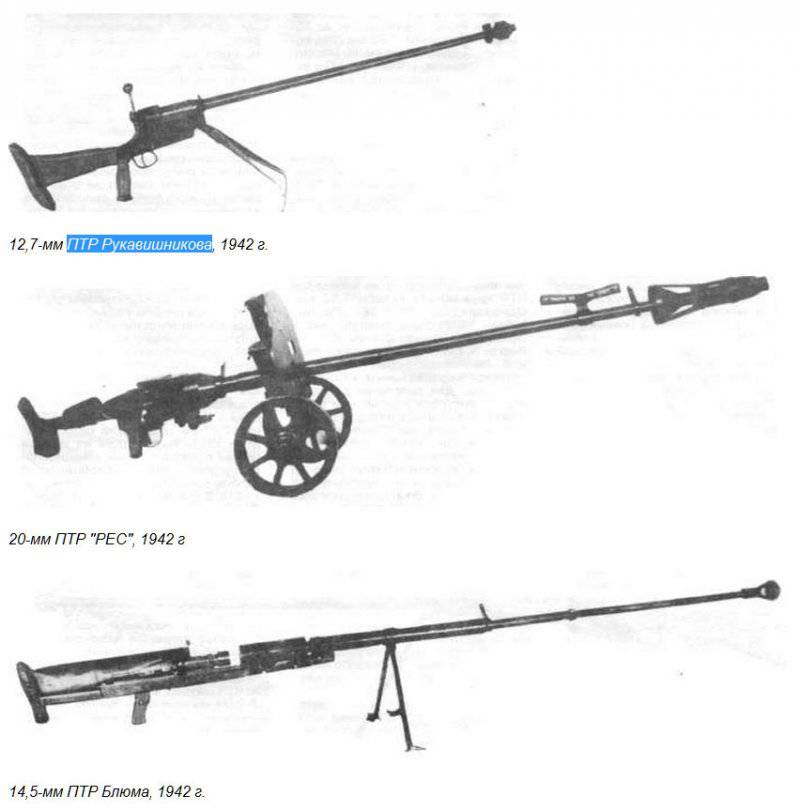
Information